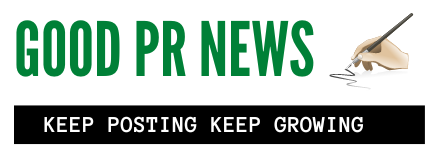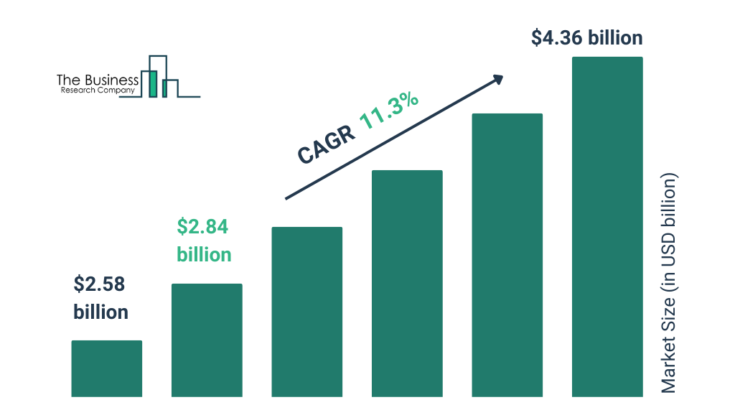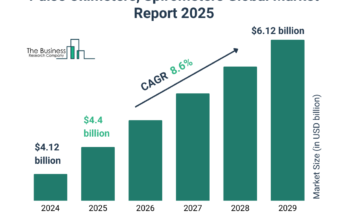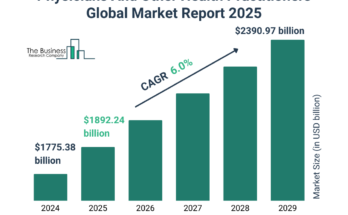What is the present valuation and projected CAGR of the protein labeling market?
The protein labeling market size has grown rapidly in recent years. It will grow from $2.58 billion in 2024 to $2.84 billion in 2025 at a compound annual growth rate (CAGR) of 10.1%. The growth in the historic period can be attributed to increasing demand for protein-based therapeutics, growing adoption of proteomics research, expanding range of applications for protein labeling, rising awareness of the benefits of protein labeling, increasing availability of skilled labor, increasing prevalence of chronic diseases.
The protein labeling market size is expected to see rapid growth in the next few years. It will grow to $4.36 billion in 2029 at a compound annual growth rate (CAGR) of 11.3%. The growth in the forecast period can be attributed to personalized medicine, point-of-care (POC) testing, growth in proteomics, increased funding and investment in life sciences, rising healthcare expenditure. Major trends in the forecast period include advances in protein labeling technologies, quantum dots and nanoparticles, multiplexing and high-throughput labeling, biorthogonal labeling, integration of artificial intelligence (ai), sustainable labeling reagents, drug development.
Get Your Free Sample of The Global Protein Labeling Market Report:
https://www.thebusinessresearchcompany.com/sample.aspx?id=3417&type=smp
What key drivers have fueled the protein labeling market’s development over the years?
Increased spending on the R&D of proteomics and genomics is driving the growth of the protein labeling reagents market. Proteomics is the study of the overall protein content of a cell, tissue, or organism. Protein labeling methods before separation and analysis are essential during proteomic profiling approaches. For instance, the National Institutes of Health (NIH) of the United States, funded $37 billion for biomedical research. This funding is for life sciences research that supports study at a molecular level for the understanding of fundamental processes by which diseases develop, the identification of biomarkers that signal the presence of disease, or identification of genes or proteins responsible for the disease. The Novo Nordisk Foundation granted a grant of up to $1.5 million to the University of Copenhagen to establish a mass spectrometry facility, which marks a new and exciting step in protein research. Therefore, the increased spending on research and development of proteomics and genomics is driving the market.
What is the segmentation for the protein labeling market?
The protein labeling market covered in this report is segmented –
1) By Product: Reagents, Protein, Enzymes, Probes/ Tags, Monoclonal Antibodies
2) By Labeling Method: In-vitro Labeling, In-vivo Labeling
3) By Application: Cell Based-Assay, Fluorescence Microscopy, Immunological Techniques, Mass Spectrometry, Protein Micro Assay
Subsegments:
1) By Reagents: Fluorescent Dyes, Enzyme Labels, Chemiluminescent Reagents, Radioactive Labels
2) By Protein: Recombinant Proteins, Native Proteins, Modified Proteins
3) By Enzymes: Alkaline Phosphatase, Horseradish Peroxidase, Other Enzymatic Labels
4) By Probes Or Tags: Biotin Labels, Antibody Tags, Fluorophore Probes, Affinity Tags
5) By Monoclonal Antibodies: Primary Monoclonal Antibodies, Secondary Monoclonal Antibodies, Conjugated Monoclonal Antibodies
Order your report now for swift delivery
https://www.thebusinessresearchcompany.com/report/protein-labelings-global-market-report
Who are the most influential companies in the protein labeling market?
Major companies operating in the protein labeling market include Thermo Fisher Scientific Inc., Merck KGaA, PerkinElmer Inc., GE HealthCare Technologies Inc., F. Hoffmann-La Roche AG, Agilent Technologies Inc., BIO-RAD LABORATORIES, Kirkegaard & Perry Laboratories, LI-COR Inc., Kaneka Corporation, Promega Corporation, Eurogentec S.A., Luminex Corporation, New England Biolabs Inc., Seracare Life Sciences Inc., Abcam plc., ZEDIRA GmbH, NanoTemper Technologies GmbH, TriLink BioTechnologies LLC., Waters Corporation, AMETEK Inc., HORIBA Ltd., Spectris plc., METTLER TOLEDO International Inc., Shimadzu Corporation, Hitachi High-Tech Corporation, Attana AB, Affinité Instruments, Biosensing Instruments
How will emerging trends drive the protein labeling market throughout the forecast period?
Drawbacks related to protein labeling techniques are expected to hinder the market. Label-free techniques are preferred over labeled techniques because of the drawbacks associated with them, such as wet-lab complexity and flexibility. While label-free samples can be measured without much preparation, wet lab pre-treatment is required for all labeling techniques. Samples must be labeled with metabolic (e.g., SILAC) or chemical (e.g., iTRAQ or TMT) reagents and the different conditions have to be combined. Therefore, label-free techniques are less prone to wet lab errors than labeling techniques. Label-free approaches have the advantage of being highly adaptable, even after the study has begun. New samples can be included at any time, but labeled approaches require the same number (n) of each condition. New samples may not be included in the study if they cannot be physically mixed and measured with the control. Labeled techniques such as the Super-SILAC approach reduce this problem but must also be carefully planned. These disadvantages make label-free techniques preferable. Therefore, drawbacks associated with protein labeling techniques are expected to hinder the market.
What are the major regional insights for the protein labeling market, and which region holds the top position?
North America was the largest region in the protein labeling market in 2024. The regions covered in the protein labeling market report are Asia-Pacific, Western Europe, Eastern Europe, North America, South America, Middle East, and Africa.
What Does The Protein Labeling Market Report 2025 Offer?
The protein labeling market research report from The Business Research Company offers global market size, growth rate, regional shares, competitor analysis, detailed segments, trends, and opportunities.
Protein labelling refers to the process of detecting or purifying the labelled protein and its binding partners by using the proper molecular labels. Most biological research uses one of three basic categories of protein labels: biotin, enzyme conjugates, or fluorescence probes.
Purchase the exclusive report now to unlock valuable market insights:
https://www.thebusinessresearchcompany.com/purchaseoptions.aspx?id=3417
With over 15000+ reports from 27 industries covering 60+ geographies, The Business Research Company has built a reputation for offering comprehensive, data-rich research and insights. Armed with 1,500,000 datasets, the optimistic contribution of in-depth secondary research, and unique insights from industry leaders, you can get the information you need to stay ahead.
Our flagship product, the Global Market Model, is a premier market intelligence platform delivering comprehensive and updated forecasts to support informed decision-making.
Contact Us:
The Business Research Company
Europe: +44 207 1930 708
Asia: +91 88972 63534
Americas: +1 315 623 0293
Email: info@tbrc.info
Follow Us On:
LinkedIn: https://in.linkedin.com/company/the-business-research-company
Twitter: https://twitter.com/tbrc_info
Facebook: https://www.facebook.com/TheBusinessResearchCompany
YouTube: https://www.youtube.com/channel/UC24_fI0rV8cR5DxlCpgmyFQ
Blog: https://blog.tbrc.info/
Healthcare Blog: https://healthcareresearchreports.com/
Global Market Model: https://www.thebusinessresearchcompany.com/global-market-model




